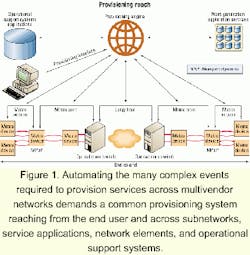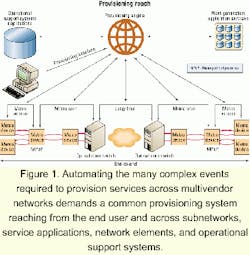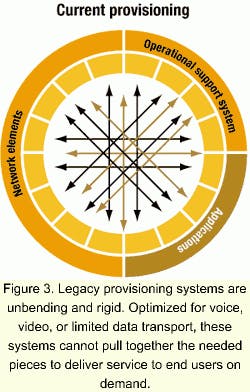Soothing the pain of optical provisioning needs
Service providers face many challenges and requirements for next-generation provisioning systems capable of breaking the proverbial bottleneck.
RANDY FULLER, Emperative
Optical-network providers have yet to break the so-called "provisioning bottleneck." They've rushed to meet the demand for physical transport and deployed hardware platforms with unheard of port density and throughput. But many have underestimated the complexity of provisioning service in a multivendor (even multiservice) environment.
Time-consuming, manual provisioning processes delay service rollouts and headlock network operators, preventing timely response to customer requests. Provisioning service in a timely, reliable, and cost-effective way will continue to hold back metro-access providers from meeting the demand for their services.
To take full advantage of the promise of optical technology, providers must be able to automate the provisioning of circuits across the diverse equipment deployed in optical networks. The ability to provision circuits end-to-end across multivendor access metropolitan and long-haul networks in ring or mesh configurations from a single, unified provisioning system is the key to generating a sustainable competitive advantage.
Providers that achieve this unity will be able to activate circuits faster, introduce new services quickly, accelerate revenue generation, scale to accommodate market demand, build closer bonds with subscribers, and enable automated self-service activation. Carriers worldwide are aggressively building out optical infrastructures to support growing bandwidth demands and reduce capital costs.In both metropolitan-area networks (MANs) and long-haul networks, SONET rings are being upgraded to support increased bandwidth requirements. DWDM equipment is being aggressively deployed to multiplex an ever-increasing number of channels across a single strand of fiber. Lambda switches are being deployed to deliver Internet Protocol (IP) services directly over optical infrastructure without the burden of SONET overhead. Innovation and technology advancements will continue to fuel service-provider spending for the foreseeable future.
Billions spent on cutting-edge equipment is all for naught unless services can be delivered quickly and cost-effectively. Automated, single-touch provisioning is therefore a critical success factor for service providers. But achieving rapid, error-free, automated provisioning is not a trivial task. It requires the coordination of dozens of separate systems (see Figure 1). There are still a number of other challenges that must be overcome:
- Support for multiple vendors. Networks are based on equipment from multiple vendors. Today's "swivel chair" provisioning-in cross-training, skilled operators slide their chairs across the floor to make changes in multiple element-management systems (EMSs) to provision a single connection-is cumbersome, slow, expensive, and a barrier to scalability.
- Support for multiple technologies. With networks consisting of a mix of SONET, DWDM, ATM, IP, and Multiprotocol Label Switching (MPLS) technologies and standards, achieving automated one-touch provisioning of even a single circuit is a considerable challenge.
- Support for multiple providers. Few carriers have the infrastructure in place to deliver true end-to-end connectivity and services entirely over their own networks. Service delivery needs to be coordinated among multiple providers to enable end-to-end activation, often increasing the time it takes to deliver services to end customers.
- Reliability. To protect brand value, accelerate revenue, and ensure customer satisfaction, providers must be able to reliably activate circuits and maintain high availability in a rapidly changing and sometimes uncertain network environment.
- Scalability. The market demand for optical-networking service is tremendous, so infrastructure to support new services must be able to scale smoothly to accommodate that demand. This capability requires that providers be able to increase both the number of subscribers and availability of diverse services to existing subscribers, while containing the cost of network operators.
- Adaptability. Optical-networking equipment changes constantly to support emerging standards and technologies. Providers need a flexible provisioning solution that can support their constantly evolving network requirements.
- OSS integration. The ability to integrate with operational support-system (OSS) applications such as order entry, customer care, network monitoring, and billing is critical to automating the entire provisioning process.
- Transition to next-generation services. Providers must integrate provisioning with value-added applications such as offsite data storage and on-demand videoconferencing to improve profitability and build closer ties to customers without making additional system investments.
This system gives network operators a consolidated view of the network information required for the provisioning of circuits and services across a service provider's network. Activating and managing these circuits-and the services that can be delivered over them-involves a number of basic steps (see Figure 2).
The provisioning system captures information on network resources via autodiscovery, batch load from external network inventory systems, or manual entry. A point-and-click network-manager interface allows providers to manage all of their sites and associated hardware within each site from a single interface. It features intuitive network mapping to create a logical picture of the network elements and allows network operators to navigate the information quickly and easily.
Once the IP address of each node is captured, the provisioning system performs autodiscovery directly from the node or through its EMS to ascertain the characteristics of each note, including port information and the status of existing cards and crossconnects. Additionally, a link-manager interface allows network operators to add, modify, or delete links. Through this interface, operators reach data such as higher-level node information, port information, unique link name, link rate, and the type of link (e.g., SONET).
Provisioning requests can reach the provisioning systems from a variety of sources, including order-entry systems, sales force automation systems, customer-relationship, management systems, and Websites. Once an order is received, the provisioning engine automates pre-activation qualification against billing systems, service availability databases, and other OSS applications based on an individual service provider's business processes. For the creation and activation of an optical circuit, a connection manager of sorts supports point-and-click creation and deletion of the subnetwork connections that compose an end-to-end circuit between two ports.
An easy-to-use graphical user interface (GUI) interfaces with network elements or their respective element managers to automatically activate circuits across a diverse network infrastructure. Inventory discrepancies causing activation requests to fail is a major obstacle to streamlined provisioning. The provisioning system addresses that by providing comprehensive validation and rollback with instant notification of failed requests as well as network autodiscovery, allowing rapid issue diagnosis and resolution.
Service providers require maximum flexibility for selecting routing priorities. Any next-generation provisioning system offers configurable algorithms, so providers can base route selection on their own particular business policies and network topologies. The provisioning system calculates possible routes for a requested circuit, then scores them according to a flexible set of parameters defined by the provider. It activates the circuit over the route with the best score.
Here are some of the configurable parameters applied to optimize the routing of traffic flows:
- Hop count. Routes can be graded by hop count and selected based on the fewest number of hops.
- Weighted links/nodes. This parameter can be either explicit (entered when the link/node is added) or implicit (inverse to how much bandwidth remains on a link). A cost is associated with links and/or nodes and the provisioning system selects the lowest cost path.
- Include/exclude. Specific nodes or links can be included or excluded, usually to support requirements for high levels of redundancy.
- Time. The amount of time it takes to find the optimal path through a complex network increases exponentially with the size of the network. Since many carriers require on-demand provisioning, they have the flexibility to restrict the time available to make route calculations. For example, the provisioning system could be configured to calculate routes for 200 msec, then select the best route found during this time period.
- Subnetwork connections. A path across the network can be broken down into subnetworks so that routes can be calculated between these various subpaths.
A next-generation provisioning system armed with route optimization would offer powerful routing algorithms that give providers maximum control over selecting routes based on business policies. Practical and robust routing algorithms allow providers to make efficient use of equipment and bandwidth, while ensuring utmost control of circuit provisioning.
Automated circuit activation is the foundation for the overall service delivery to a customer, but the other elements need to be smoothly integrated to fully deliver on customer expectation. Integration of back-office OSS systems and revenue-generating application services such as storage area networks (SANs), disaster recovery, and high-bandwidth enterprise applications are just as critical to manage.
Unlike current provisioning systems, next-generation systems go beyond the initial network activation by allowing providers to seamlessly integrate any other required systems. Using the system's extensible markup language (XML) interface, orders for service components from other providers can be automated, as well.
Due to the number of complex components involved in broadband provisioning-and the speed at which those components change-achieving automated, reliable service provides extraordinary intelligence. Next-generation provisioning systems provide this intelligence through a sophisticated, state-machine-based engine that connects each element in a provider's complex network and service environment.
Currently, provisioning between network and service environments, network elements, OSSs, and service applications is accomplished across rigid, inflexible software systems. But to meet demands of new services, a robust, open architecture employs flexible process models, built-in logic, time-aware intelligence, a persistent database, and easy-to-use GUIs to provision a multitude of services-all within a highly scalable, fault-tolerant environment.
Next-generation provisioning systems include process models that are key to automating the intricate operations involved in provisioning. Current provisioning systems do not have the flexibility to handle service events as workflows. They are rigid and inflexible (see Figure 3).But the next-generation system has models-graphically represented by the system's modeling interface-to define the business processes required to deliver services. They contain the master plan for handling jeopardy situations, hardware latencies, interactions, and interdependencies-information that must otherwise be manually programmed for every condition.
Provisioning models contain patterns of specialized logic to automate all operations, including forward and rollback processing, dependent relationships, simultaneous tasks, and error-condition processing. As users subscribe to a service, the provisioning system creates a new instance of the process model for each subscriber. This highly granular data delivers the flexibility to modify, back up, and restore data down to the individual end-user level. Most likely, an embedded database ensures that all data is stored persistently and all changes are governed strictly by transactions specified in the model.
For example, a provisioning model could be defined to support management of customer-affecting events such as a port failure on a connection between two locations. The provisioning system would receive an alarm from the network and send the appropriate information to the network monitoring system to correlate the alarm with a specific customer. Once affected customers are identified, the provisioning system also dynamically updates the trouble ticketing system at different stages in the correction process so customer-service representatives can communicate the most accurate information to customers.
In addition to a robust platform for managing service provisioning, next-generation systems will offer rich libraries of preconfigured intelligent interfaces to perform the configuration actions to external network elements and systems. These interfaces reach out to the network and operations environment to execute various activities such as configuring devices and server; predictably managing jeopardy, error, and latency conditions; and interfacing with third-party OSS applications. Such interfaces provide maximum flexibility for establishing crossconnects and maximizing investments in network equipment.
Ideally, any intelligent interface can be used by any process model and be dynamically modified and loaded without a restart of the underlying provisioning engine. Plugging preconfigured interfaces into models allows for rapid introduction of new network elements. Because it seems new switching and routing platforms have been coming to market every day, interfaces for new network elements must be created easily in a matter of engineering weeks from the start of development through quality assurance.
It is an obvious requirement, but provisioning systems will need to be scalable to support a single site or complex network. Multithreaded applications that take full advantage of multiprocessor architectures allow for scalability. Clustering features will allow any number of the underlying engines to function as one engine from the point of view of client applications. Engines should also be fully distributable to manage large volumes of transactions or geographically dispersed sites. Theoretically, there are no hard limits to the numbers of simultaneous clients supported by such a system.
Carrier-class provisioning means the system can never be unavailable when a customer wants to make a service change, even when hardware fails or is being upgraded. Next-generation provisioning systems provide database replication and instant fail-over capabilities as standard features to make sure provisioning is always accessible. Since the new breeds of provisioning systems must be hardware agnostic, the primary and secondary servers can be different models from different vendors, thus maximizing cost efficiency. These features can be used in two ways:
- Hot standby. A continually replicated backup engine constantly monitors the primary engine's heartbeat, taking over instantly if the heartbeat ceases. When the primary engine is brought back online, processing can be restored.
- Migration. A replicated environment can be created on the new machine, so it can seamlessly take over for the other machine on command.
The next-generation breed of provisioning systems allows carriers to rapidly create and activate new services that take advantage of the performance and capacity of today's optical-network equipment, while providing a platform for the rapid introduction of tomorrow's advances. As networks evolve, we will see these systems serving as the central point for provisioning in multivendor metropolitan and long-haul networks. They will also integrate with existing OSS systems and value-added service applications to automate full end-to-end service delivery.
But these new provisioning systems will require inherent intelligence to efficiently scale services without a corresponding increase in the number of network operations personnel. Rapid, reliable provisioning of next-generation circuits and services is a key competitive weapon that can help carriers succeed in meeting their business goals for revenue and profitability.
Randy Fuller is vice president of marketing at Emperative (Waltham, MA). He can be reached via the company's Website, www.emperative.com.



